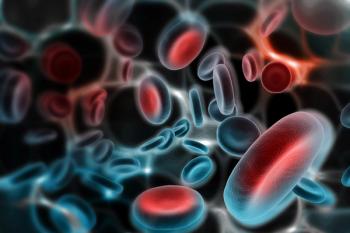
Does Frontline R2CHOP Reduce CNS Relapse Risk in DLBCL?
There may be prophylactic benefit from using lenalidomide, an orally bioavailable CNS-penetrating agent, combined with R-CHOP in the upfront setting.
Adding lenalidomide to front-line treatment with R-CHOP (rituximab plus cyclophosphamide, doxorubicin, vincristine, and prednisone; R2CHOP) in patients with diffuse large B-cell lymphoma (DLBCL) was associated with a lower-than-expected rate of central nervous system (CNS) relapse, according to a retrospective
“Our finding that frontline R2CHOP may lower the risk of CNS relapse in patients with DLBCL supports an ongoing trend in clinical studies where other novel small molecules are being investigated in the upfront setting in combination with R-CHOP, such as ibrutinib (NCT01855750), venetoclax (NCT02055820), and everolimus (NCT01334502),” wrote Ayed O. Ayed, MD, Mayo Clinic, Rochester, Minnesota, and colleagues. “The impact of such R(X)CHOP combinations (where X represents a novel agent molecule) on CNS relapse is yet to be defined.”
According to the study, relapse of aggressive non-Hodgkin lymphoma to the CNS is rare and associated with poor outcomes. Lenalidomide is an immunomodulatory agent that research has shown to be active in heavily pretreated CNS lymphoma.
Because lenalidomide can cross the blood-brain barrier, Ayed and colleagues hypothesized that adding lenalidomide to R-CHOP might lower the risk of CNS relapse in patients with DLBCL. The researchers looked at records for 136 patients with DLBCL from twotrials of R2CHOP.
Patients were classified by CNS-International Prognostic Index score as being at low (10.3%), intermediate (71.3%), or high risk (18.4%) for CNS relapse. There was a median follow-up period of more than 4 years.
Only one of the included patients had CNS relapse, which equated to an incidence of 0.7%. The estimated 2-year CNS relapse rate was 0.9% for the entire group of patients. The patient with CNS relapse had GCB (germinal center B-cell) phenotype disease, extensive extranodal disease, and a CNS-IPI score of 4.
By risk group, the estimated 2-year CNS relapse rates for the low-, intermediate-, and high-risk groups were 0%, 0%, and 5.0%, respectively.
“When compared with contemporary DLBCL patients treated with R-CHOP from the MER [University of Iowa and Mayo Clinic Specialized Programs of Research Excellence Molecular Epidemiology Resource] database, the overall 2-year CNS relapse rate in the R2CHOP cohort is low (0.9 vs. 1.8%),” the researchers wrote.
In the study, the researchers also discussed ongoing variability and controversy over optimal CNS prophylaxis strategies, driven “primarily by lack of strong evidence for benefit of current strategies and the difficulty of conducting definitive randomized studies in this area,” they wrote.
“Our study suggests the potential prophylactic benefit of utilizing lenalidomide, an orally bioavailable CNS-penetrating agent, when combined with R-CHOP in the upfront setting,” the investigators concluded. “The two phase 2 trials analyzed in this study have already demonstrated safety and manageable toxicity of such a combination.”
Newsletter
Stay up to date on recent advances in the multidisciplinary approach to cancer.


















































































